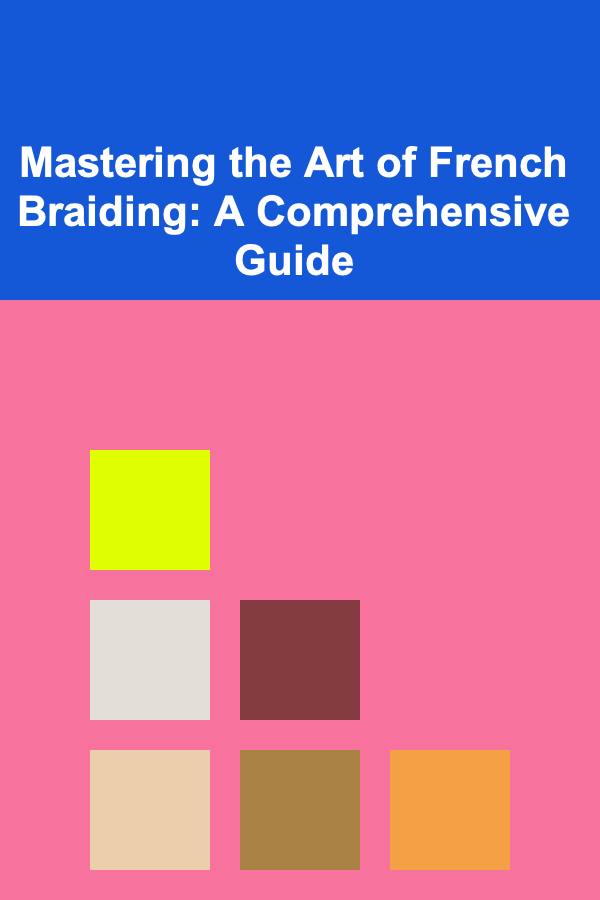
Mastering the Art of French Braiding: A Comprehensive Guide
ebook include PDF & Audio bundle (Micro Guide)
$12.99$10.99
Limited Time Offer! Order within the next:

French braiding is a timeless and elegant hairstyle that can be adapted for various occasions, from casual outings to formal events. While it might seem daunting at first, mastering the art of French braiding is achievable with patience, practice, and a solid understanding of the fundamental techniques. This comprehensive guide will walk you through everything you need to know, from preparing your hair to troubleshooting common challenges, enabling you to create stunning French braids with confidence.
Understanding the Fundamentals
Before diving into the step-by-step instructions, it's crucial to grasp the core principles that underpin French braiding. At its essence, a French braid is a three-strand braid that gradually incorporates more hair as it progresses down the head. The key difference between a regular braid and a French braid lies in this gradual incorporation of additional strands.
Let's break down the key elements:
- Three Strands: Like a standard braid, a French braid relies on the interplay of three distinct sections of hair.
- Incorporation: This is the defining characteristic of a French braid. With each pass of the braid, you'll pick up a new section of hair and add it to one of the existing strands.
- Tension: Maintaining consistent tension is vital for a neat and secure braid. Too loose, and the braid will unravel; too tight, and it will strain the scalp and create an uncomfortable hairstyle.
- Practice: As with any skill, practice makes perfect. Don't be discouraged if your first few attempts are less than flawless. The more you practice, the better you'll become at controlling the strands and achieving a smooth, even braid.
Preparing Your Hair
The success of your French braid hinges on proper preparation. The right prep work will ensure that your hair is manageable, smooth, and ready to be transformed into a beautiful braid. Here's what you need to do:
1. Detangle Thoroughly
Start with completely detangled hair. Use a wide-tooth comb or a detangling brush to gently remove any knots or tangles. This will prevent snags and make the braiding process much smoother and more efficient.
2. Add Texture (Optional)
Depending on your hair type, you might want to add some texture. This is particularly helpful for fine or slippery hair, as it provides more grip and makes the braid more secure. Consider using:
- Texturizing Spray: A light mist of texturizing spray can add subtle grit and hold.
- Dry Shampoo: Even on clean hair, dry shampoo can provide volume and texture.
- Mousse: Applied to damp hair before blow-drying, mousse can create a lasting hold and add body.
3. Apply Anti-Frizz Serum (Optional)
If you have frizzy hair, applying a small amount of anti-frizz serum can help to smooth the strands and create a more polished look. Apply sparingly, as too much serum can weigh down the hair and make it look greasy.
4. Gather Your Supplies
Before you begin braiding, make sure you have everything you need within easy reach:
- Comb or Brush: For sectioning and smoothing the hair.
- Hair Ties: To secure the end of the braid. Choose hair ties that match your hair color for a seamless finish.
- Hair Clips: To hold sections of hair out of the way while braiding.
- Mirror: A mirror is essential for seeing the back of your head and ensuring that your braid is even and symmetrical.
- Hairspray (Optional): To set the braid and prevent flyaways.
Tip: Braiding slightly damp hair can make it easier to manage and prevent flyaways. However, avoid braiding soaking wet hair, as it can be more prone to breakage.
The Step-by-Step Guide to French Braiding
Now that your hair is prepped and you have your supplies ready, let's move on to the step-by-step instructions for creating a beautiful French braid:
Step 1: Section the Hair
Begin by sectioning off a triangular or rectangular section of hair at the crown of your head. This section should be about 2-3 inches wide. The size of this section will determine the thickness of the braid at the top of your head.
Step 2: Divide into Three Strands
Divide the sectioned hair into three equal strands. Hold one strand in each hand and the third strand between your fingers. These are your starting strands for the braid.
Step 3: Begin the Braid
Start by performing a standard three-strand braid. Bring the right strand over the middle strand, then bring the left strand over the new middle strand. This forms the first stitch of your French braid.
Step 4: Incorporate Hair (Right Side)
Now, pick up a small section of hair from the right side of your head, near the edge of the braid. Add this section to the right strand and bring the combined strand over the middle strand. Make sure to keep the tension even.
Step 5: Incorporate Hair (Left Side)
Next, pick up a small section of hair from the left side of your head, near the edge of the braid. Add this section to the left strand and bring the combined strand over the middle strand. Again, maintain even tension.
Step 6: Repeat the Process
Continue repeating steps 4 and 5, incorporating small sections of hair from alternating sides of your head with each pass of the braid. As you braid, try to pick up hair that is approximately the same size on each side to maintain symmetry.
Step 7: Finish the Braid
Once you have incorporated all of the hair from the sides of your head, continue braiding the remaining hair in a standard three-strand braid until you reach the end. Secure the end of the braid with a hair tie.
Step 8: Secure and Style
Secure the end of the braid with a hair tie. You can leave the braid as is, or gently pull on the edges of the braid to create a more relaxed and voluminous look. For added hold, spritz with hairspray.
Variations on the French Braid
Once you've mastered the basic French braid, you can explore a variety of variations to create different looks:
- Dutch Braid (Inside-Out French Braid): Instead of bringing the strands over the middle strand, bring them under. This creates a braid that sits on top of the hair, rather than being embedded in it.
- Side French Braid: Start the braid at the side of your head and angle it down towards the opposite shoulder.
- Double French Braids: Create two French braids, one on each side of your head. Part your hair down the middle and braid each side separately.
- French Braid Bun: After finishing the French braid, twist it into a bun and secure it with bobby pins.
- Partial French Braid: Braid only a portion of your hair, leaving the rest down. This can be used to create a variety of stylish looks, such as a French braid headband or a French braid accent.
Troubleshooting Common Challenges
Even with careful preparation and technique, you might encounter some challenges when learning to French braid. Here are some common problems and how to address them:
- Loose Braid: A loose braid can be caused by insufficient tension or slippery hair. Make sure to pull the strands taut with each pass of the braid, and use texturizing products to add grip.
- Uneven Braid: An uneven braid can result from picking up uneven sections of hair or inconsistent tension. Pay close attention to the size of the hair sections you're incorporating and strive for even tension throughout the braid.
- Bumps or Flyaways: Bumps can occur if you're not picking up the hair smoothly. Use a comb to smooth the hair as you incorporate it into the braid. Flyaways can be tamed with hairspray or anti-frizz serum.
- Difficulty Braiding the Back: Braiding the back of your head can be challenging. Use a mirror to see what you're doing and practice until you become more comfortable with the hand movements. Consider starting with a side braid until you build more confidence.
- Sore Arms: Holding your arms up for an extended period can lead to arm fatigue. Take breaks as needed and try to support your elbows on a table or counter to reduce strain.
Warning: Avoid braiding your hair too tightly, as this can damage the hair follicles and lead to hair breakage. If you experience pain or discomfort, loosen the braid immediately.
Tips for Success
Here are some additional tips to help you master the art of French braiding:
- Practice Regularly: The more you practice, the better you'll become at French braiding. Try braiding your hair a few times a week to improve your technique.
- Watch Tutorials: There are countless online tutorials that demonstrate French braiding techniques. Watch videos from different sources to learn various tips and tricks.
- Ask for Help: If you're struggling, ask a friend or family member to help you. They can provide feedback and guidance on your technique.
- Be Patient: Learning to French braid takes time and effort. Don't get discouraged if you don't master it immediately. Just keep practicing, and you'll eventually achieve your goal.
- Experiment: Once you're comfortable with the basics, experiment with different variations and styles to create your own unique looks.
- Use Quality Products: Investing in quality hair products, such as a good comb, hair ties, and hairspray, can make a significant difference in the final result.
Conclusion
Mastering the art of French braiding is a rewarding skill that allows you to create a variety of beautiful and versatile hairstyles. By understanding the fundamentals, preparing your hair properly, following the step-by-step instructions, and practicing regularly, you can overcome any challenges and achieve stunning results. So, grab your comb, gather your hair, and embark on your French braiding journey. With patience and dedication, you'll be creating flawless French braids in no time!
Reading More From Our Other Websites
- [Home Renovating 101] How to Use Smart Home Devices for Renovations to Optimize Project Management
- [Whitewater Rafting Tip 101] Streamlined Strength: Transform Your Body with These Rafting-Focused Training Tips
- [Organization Tip 101] How to Incorporate Natural Elements into Your Wellness Space
- [Personal Care Tips 101] How to Use a Fitness Tracker to Maximize Results
- [Survival Kit 101] How to Create an Emergency Survival Kit for Suburban Families Near Wildfire Zones
- [Gardening 101] From Rustic Stone Paths to Modern Minimalist Walkways: Styles to Inspire
- [Organization Tip 101] How to Use Project Management Tools for Paperwork Control
- [Organization Tip 101] Step-by-Step Guide to Applying Self-Leveling Underlayment
- [Home Lighting 101] How to Install Smart Lighting to Enhance Your Home's Ambiance
- [Home Budget 101] How to Save Money on Home Heating and Cooling Costs

How to Use Social Media to Boost Your Side Hustle and Attract Global Clients
Read More
How to Use Statement Pieces to Transform Your Home on a Budget
Read More
The Art and Science of Nurse Practitioner Practice: Balancing Evidence-Based Medicine with Compassionate Care
Read More
How To Write a Strong Follow-Up Email After No Response
Read More
How To Become an Independent Insurance Agent
Read More
How to Build a Sci-Fi Model Spaceship from Scratch
Read MoreOther Products

How to Use Social Media to Boost Your Side Hustle and Attract Global Clients
Read More
How to Use Statement Pieces to Transform Your Home on a Budget
Read More
The Art and Science of Nurse Practitioner Practice: Balancing Evidence-Based Medicine with Compassionate Care
Read More
How To Write a Strong Follow-Up Email After No Response
Read More
How To Become an Independent Insurance Agent
Read More